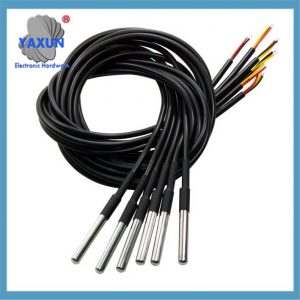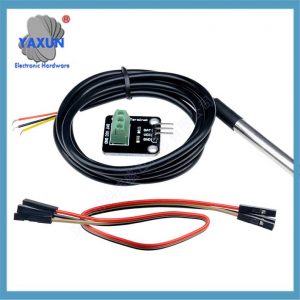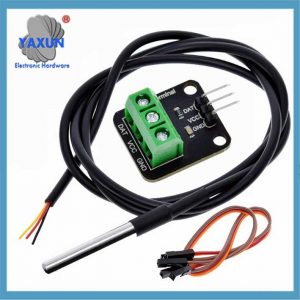DS18B20 is a digital temperature sensor based on single bus protocol. لديها دقة عالية, low power consumption and flexible installation characteristics, and is widely used in various temperature monitoring systems. Its core technical characteristics, application scenarios and selection points are as follows:
أنا. الخصائص الأساسية
Single bus communication
Only one data line is needed to complete two-way communication, support multiple devices in parallel (حتى 128 devices can be connected), and devices can be distinguished by 64-bit unique ROM ID.
High-precision temperature measurement
The temperature measurement range is -55°C ~ +125°C, and the accuracy is ±0.5°C within the range of -10°C ~ +85°C;
The resolution can be configured to 9~12 bits (default 12 أجزاء), and the highest resolution is 0.0625°C.
Integrated design
The built-in EEPROM stores the alarm threshold and resolution configuration, which will not be lost when the power is off; it supports parasitic power supply mode (no external power supply required).
Diverse packaging
Provide TO-92 packaging, stainless steel threaded packaging, magnetic packaging, إلخ., suitable for installation in narrow spaces such as pipelines, oil tanks, لوحات الدوائر, إلخ.
ثانيا. سيناريوهات التطبيق النموذجية
| Field | Application examples |
| Industrial control | Blast furnace water circulation temperature measurement, boiler temperature monitoring, cable trench temperature monitoring. |
| Consumer electronics | Smart home thermostat, agricultural greenhouse environment monitoring, computer room temperature warning system. |
| Automotive electronics | Battery pack temperature management, حماية من ارتفاع درجة حرارة المحرك (need to cooperate with metal packaging). |
| Medical equipment | Portable thermometer, ventilator airflow temperature detection. |
| Special scenarios | Ammunition depot temperature monitoring, clean room constant temperature system (strong anti-interference). |
ثالثا. نقاط الاختيار والاستخدام
Interface design
A single bus needs to be connected to a 4.7kΩ pull-up resistor, and the data line needs to provide a strong pull-up current when parasitic power is supplied.
Accuracy optimization
The conversion time at 12-bit resolution is 750ms, and the resolution can be reduced in exchange for speed in high-speed sampling scenarios.
القدرة على التكيف البيئي
للبيئات الرطبة/التآكل, stainless steel sealed packaging (such as the LTM8877 series) is selected;
For high-temperature scenarios (>100درجة مئوية), avoid using plastic-sealed TO-92 models.
Anti-collision mechanism
When multiple devices are connected in parallel, the ID needs to be traversed through the ROM search algorithm to avoid bus conflicts.
digital Output:
The DS18B20 provides digital temperature readings, meaning it doesn’t require an ADC (المحول التناظرية إلى الرقمية) on the microcontroller side.
1-Wire Interface:
It communicates using a single data line, جنبا إلى جنب مع سلك الأرض, which simplifies wiring and reduces the number of connections needed.
Parasite Power:
The sensor can operate in “parasite power” mode, drawing power directly from the data line, eliminating the need for an external power source in some cases.
دقة:
It boasts an accuracy of ±0.5°C over a typical range of -10°C to +85°C.
نطاق درجة الحرارة:
The DS18B20 can measure temperatures from -55°C to +125°C.
Unique ID:
Each DS18B20 sensor has a unique 64-bit serial number, allowing multiple sensors to be connected to the same 1-Wire bus.
Resolution:
The temperature resolution can be programmed to 9, 10, 11, أو 12 أجزاء, affecting the precision of the readings.
رابعا. Comparison with other sensors
| سمات | DS18B20 | PT100 |
| Signal type | Digital signal (حافلة واحدة) | Analog signal (تغيير المقاومة) |
| دقة | ±0.5°C(-10~85°C) | ±0.1°C (complex calibration required) |
| Interface complexity | Extremely simple (1 خط البيانات) | Requires constant current source + high-precision ADC |
| Cost | Low (<$1) عالي | (system cost >$10) |
ملحوظة: DS18B20 is suitable for low and medium temperature scenarios between -55°C and 125°C. Thermocouples are recommended for ultra-high temperatures (>200°C) and platinum resistors are recommended for ultra-low temperatures (<-55°C).
 English
English Afrikaans
Afrikaans العربية
العربية বাংলা
বাংলা bosanski jezik
bosanski jezik Български
Български Català
Català 粤语
粤语 中文(简体)
中文(简体) 中文(漢字)
中文(漢字) Hrvatski
Hrvatski Čeština
Čeština Nederlands
Nederlands Eesti keel
Eesti keel Suomi
Suomi Français
Français Deutsch
Deutsch Ελληνικά
Ελληνικά हिन्दी; हिंदी
हिन्दी; हिंदी Magyar
Magyar Bahasa Indonesia
Bahasa Indonesia Italiano
Italiano 日本語
日本語 한국어
한국어 Latviešu valoda
Latviešu valoda Lietuvių kalba
Lietuvių kalba македонски јазик
македонски јазик Bahasa Melayu
Bahasa Melayu Norsk
Norsk پارسی
پارسی Polski
Polski Português
Português Română
Română Русский
Русский Cрпски језик
Cрпски језик Slovenčina
Slovenčina Slovenščina
Slovenščina Español
Español Svenska
Svenska ภาษาไทย
ภาษาไทย Türkçe
Türkçe Українська
Українська اردو
اردو Tiếng Việt
Tiếng Việt



